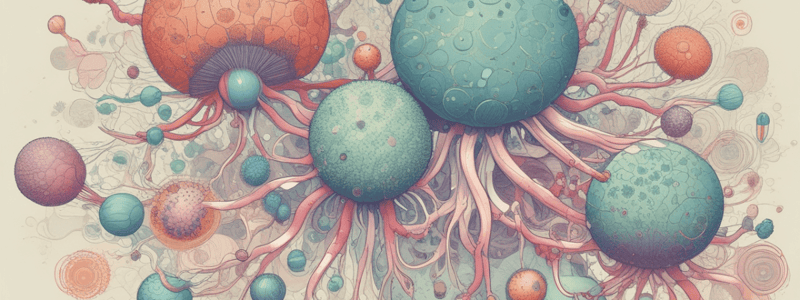Podcast
Questions and Answers
What is the first level of organisation in multicellular organisms?
What is the first level of organisation in multicellular organisms?
Cells
Give an example of an animal tissue and explain its function.
Give an example of an animal tissue and explain its function.
Muscle tissue; Muscle cells contract together to make the body move.
What is the function of the xylem tissue in plants?
What is the function of the xylem tissue in plants?
Carry water around the plant
Define an organ in terms of organisation in multicellular organisms.
Define an organ in terms of organisation in multicellular organisms.
How are nerve cells and nerve tissue related in multicellular organisms?
How are nerve cells and nerve tissue related in multicellular organisms?
What is the function of the liver in the human body?
What is the function of the liver in the human body?
Describe the function of the leaf in a plant.
Describe the function of the leaf in a plant.
What is the role of the respiratory system in the human body?
What is the role of the respiratory system in the human body?
Explain the function of the bladder in the human body.
Explain the function of the bladder in the human body.
Define a multicellular organism and its components.
Define a multicellular organism and its components.
Flashcards are hidden until you start studying
Study Notes
Levels of Organisation in Multicellular Organisms
- Multicellular organisms are composed of many cells, which are the building blocks of life and the first level of organisation.
- The second level of organisation is a tissue, which is a group of similar cells that work together to perform a specific function.
- Examples of animal tissues include muscle tissue, which enables movement, and nervous tissue, which facilitates message transmission.
- Examples of plant tissues include xylem, which transports water around the plant.
- The third level of organisation is an organ, which is made up of different tissues that work together to perform a specific function.
- Main organs in animals and plants include:
- Brain: controls the body
- Lungs: exchange oxygen and carbon dioxide
- Heart: pumps blood
- Liver: removes toxins and produces bile
- Intestine: absorbs nutrients
- Stomach: digests food
- Kidney: filters blood and produces urine
- Bladder: stores urine
- Stem: supports the plant
- Leaf: absorbs sunlight for photosynthesis
- Root: anchors the plant and absorbs water and minerals
- The fourth level of organisation is an organ system, which is a group of organs that work together to perform a specific function.
- Examples of organ systems include:
- Circulatory system: transports materials in the blood
- Respiratory system: exchanges oxygen and carbon dioxide
- Reproductive system: produces new organisms
- Plant structure is primarily organised into organs or tissues, with flowers being an exception as they contain both male and female sex organs, forming the reproductive system.
- The fifth level of organisation is a multicellular organism, which is made up of multiple organ systems working together to perform all necessary life processes.
Studying That Suits You
Use AI to generate personalized quizzes and flashcards to suit your learning preferences.




